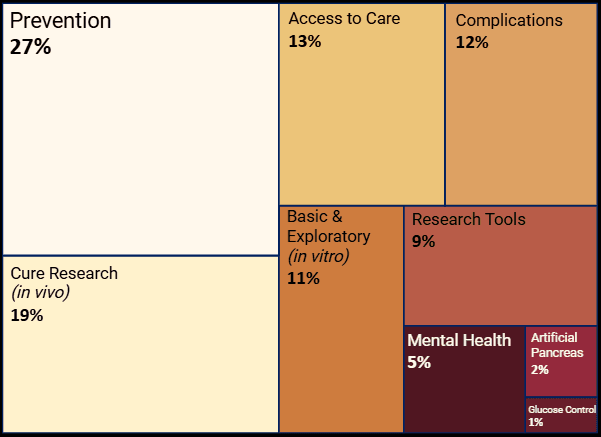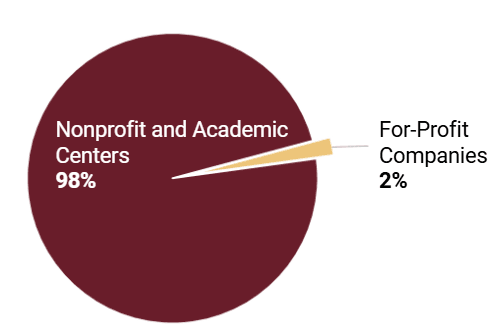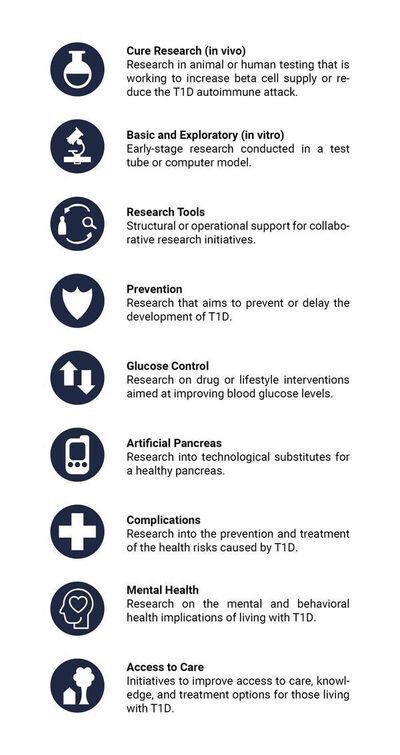At a Glance
- In FY24, Breakthrough T1D contracted 130 new grants, totaling $92M to be allocated over several years.
- 27% of research funding went to prevention.
- Cure research fell to second priority with 19% of total contracted funding (vs. 27% in FY23).
- Access to care, a new research category, took third place with 13% of all funding.
- The largest grant ($9M) went to complications research, totaling 10% of all funds.
July 24, 2025
This report reviews new research grants contracted during the 2024 fiscal year (FY24) by Breakthrough T1D, the leading T1D-focused nonprofit. Highly influential in the field of diabetes, Breakthrough T1D distributes millions of dollars each year in research grants. Looking at new grants allows us to gauge the organization’s most up-to-date research priorities and see how they align with stated objectives.
‘Contracted’ refers to the total amount committed or promised during FY24 (July 1, 2023 – June 30, 2024) to be allocated over several years. This is different from actual research grant spending in FY24, which was reported earlier this year.
It is important to make this distinction, as the newest grant commitments reflect what kinds of research receive the most attention today.
JDCA staff reviewed and categorized each project (see Appendix A for categories). In FY24, Breakthrough T1D reduced the number of contracted grants compared to the prior year (157 in FY23, 130 in FY24). The total value also fell, from $146 million to $92 million (a $54 million reduction).
Most Breakthrough T1D grants are publicly available in the grant center. This database is an excellent source of information for the T1D community and a strong example of information transparency.
Prevention Displaces Cure Research as #1
Chart A: Breakthrough T1D FY24 Research Grant Spending by Category (100% = $92 Million)

In FY24, prevention displaced cure research as the top research grant category. Prevention grew from $22 million in FY23 to $25 million in FY24. Meanwhile, cure research dropped from $40 million to $17 million, a staggering decline. As a result, prevention as a percentage of total research grant spending rose from 15% to 27%, while cure research moved in almost exactly the opposite direction, from 27% in FY23 to 19% in FY24.
Prevention
27% is the highest percentage prevention has seen since JDCA began tracking this information. In FY24, the $25 million committed to prevention was given to 42 different grants.
The largest grant in this category was a promise of $3 million to the Regents of the University of Colorado, accounting for 12% of all funding in this category. This supports the Autoimmunity Screening for Kids (ASK) project, screening children for antibodies that indicate pre-symptomatic T1D, celiac disease, and offering early intervention and education.
Researchers aiming to prevent or delay T1D have not lost momentum, and we continue to see a sizeable number of these projects across the field today. The FDA approval of Tzield in 2023, a therapy that delays onset by an average of two years, has driven competition. It must be said that therapies aiming to prevent or delay the onset of T1D will do no good for those living with the disease today. Prevention is not a cure.
Cure Research
Cure research, now the second-largest grant spending category, refers to research evaluated in an animal or human model, working to increase beta cell supply or tackle the autoimmune attack. In FY24, no other grant spending category decreased as much as cure research.
Thirty cure research grants were contracted in FY24. Of those, eighteen address cell protection or cell supply (see chart B). Four are researching both supply and protection solutions together and could have the potential to become Practical Cures in the future. The remaining eight projects address general islet transplantation topics, such as sites and methods to boost cell health outside of autoimmune protection.
Chart B: Breakthrough T1D FY24 Cure Research Category Focus

Additionally, stem cell-derived beta cells (sBCs) and beta cell regeneration were the most common subcategories of cell supply projects. For protection solutions, research aiming to stop the autoimmune attack at its root was the most common theme (opposed to hiding cells with gene editing or a device) in fourteen different projects.
Access to Care
This is the first year we have specifically labeled ‘access to care’ as a main spending category, following several years of increased importance at Breakthrough T1D.
Previously, this was bundled in the ‘social impact’ category. In FY24, social impact is split into two new, smaller research categories to best distinguish the intended impact: access to care and mental health (see Appendix B). Note that these have not been retroactively recategorized in Appendix B but will be fully updated in our next annual review.
Access to care is the third-largest spending area at $12 million. Despite only eight grants in this new category, they amount to 13% of the total funding promised in FY24. This cements the continued importance placed on access to care by Breakthrough T1D.
5 Biggest Grants
The five largest contracted grants of FY24 totaled $26 million altogether, 28% of all promised research grant funding.
- $9 million (Complications): To Joslin Diabetes Center to fund the SUGARNSALT trial, a project aiming to slow the progression of severe diabetic kidney disease. This one project will receive 10% of all contracted funding.
- $6 million (Research Tools): To the Regents of the University of California, San Francisco. Funding will support the Northern California JDRF Center of Excellence.
- $6 million (Access to Care): To the Brigham and Women’s Hospital for the PEN-Plus program, working to expand worldwide access to care.
- $3 million (Prevention): To the Regents of the University of Colorado to support the Autoimmunity Screening for Kids (ASK) program, screening for T1D and celiac disease.
- $2 million (Prevention): To St. Vincent's Institute of Medical Research to support early-intervention research to delay or prevent the onset of T1D.
Other Changes
Smaller research categories also experienced noteworthy changes.
Complications
Complications grants saw a small uptick in research funding as a percentage of the total. In FY23, it was 8% and rose to 12% in FY24. This is the highest percentage of complications since JDCA began tracking this information.
Glucose Control & Artificial Pancreas
Grants to support glucose control and artificial pancreas projects have dipped to their lowest levels. Glucose control decreased from 5% of contracted research funding in FY23 to 1% in FY24. Artificial pancreas saw a similar dip from 5% to 2%.
Academic and Commercial
The majority of contracted grants went to academic institutions; a minority went to for-profit companies. Out of 130 grants contracted, only four went to commercial entities. This totaled $2 million, amounting to 2% of all grants given (see chart C). Note, these numbers do not include investments made by the T1D Fund, a venture philanthropy subsidiary of Breakthrough T1D.
Chart C: Nonprofit vs. For-Profit Grant Allocation (Percentage)

Appendix A: JDCA Grant Category Definitions

Appendix B: Breakthrough T1D Categorical Research Grant Trends (as Percentage of Total Funding)

*Note: Mental Health and Access to Care result from splitting Social Impact into two. Prior years' projects, historically categorized as Social Impact, have not yet been revised into these newer categories. This will be fully updated at a later date.
